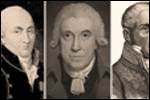
|
|
BOOKS AND ARTICLES
Charles Augustin de Coulomb (1736-1806). Biography of a scientist Directory / The life of remarkable physicists
The unit of electric charge and the law of electrostatics, which are studied in schools, are named after him. Charles Augustin de Coulomb was born on June 14, 1736 in Angouleme (Southern France) into a wealthy noble family (his father was a major royal official). He studied at the prestigious Quatre-Nation College (D'Alembert and Lavoisier were students of this college), where he became interested in mathematics and wrote several works, for which he was elected a member of the scientific society in Montpellier. In 1758, Coulomb entered the military school in Mézières with a degree in military engineering and brilliantly graduated from college in 1761. He, the only one from the entire graduation, was awarded the military rank of first lieutenant. But the military career did not work out. The young officer was sent to a distant overseas colony, to the island of Martinique, where he built bridges, roads, and fortifications for 9 years. Only in 1772 Coulomb managed to escape from the "green hell" and return to France. Here he continues to work as a military engineer in Cherbourg, Besancon and other places and engage in science. Of course, he was primarily interested in the problems of mechanics. For scientific work on the calculation of architectural structures, Coulomb in 1774 was elected a corresponding member of the French Academy of Sciences. He was engaged in the study of the forces of friction, and the formula for determining the force of friction, which is now being studied in schools, was proposed by Coulomb. In 1781 Coulomb was elected an academician. In those years, he was called the "engineer of the king", many Parisian buildings were designed by him. Already in the 80s of the eighteenth century. Coulomb became interested in the electric forces of attraction and repulsion. Is it possible to measure such small forces? Coulomb showed amazing ingenuity and in 1784 built a device for measuring ultra-small forces - a torsion balance. Thanks to torsion weights, Coulomb set up a series of experiments and in 1785 formulated his famous law: the force of attraction (or repulsion) between charges is directly proportional to the product of the charges and inversely proportional to the square of the distance between them. Coulomb was proud that the record of his law is similar to the record of Newton's law of universal gravitation, but in Newton's law there was only attraction. Subsequently, after the death of Coulomb, in 1810 the English physicist Henry Cavendish died. Analyzing his papers, the researchers found that Cavendish discovered the law of electrostatics as early as 1771, but for some reason did not publish it. Science, like history, does not know the subjunctive mood. I didn't print it - it's my own fault. Therefore, the law rightfully bears the name of Charles Coulomb. During the French Revolution, the nobleman and officer Coulomb was forced to hide in the small town of Blois. When the revolution died down, an excellent engineer and scientist again found himself in demand and continued his activities, dealing, in particular, with the problems of magnetism. In 1802, Napoleon summoned Coulomb. A small digression - Napoleon literally idolized scientists. There is also such an example. The great French mathematician Laplace was given the title of count by Napoleon and appointed minister. When Laplace successfully failed the work of the minister, Napoleon did not scold him, but affectionately said: "Go, Laplace, and do the real thing." Coulomb Napoleon awarded the rank of general and the high position of Inspector General. The last years of his life Coulomb lived in Paris, surrounded by respect and fame. Coulomb died on August 23, 1806. << Back (Table of contents) Forward >> (James Watt)
 Read and write useful comments on this article. Read and write useful comments on this article.
Machine for thinning flowers in gardens
02.05.2024 Advanced Infrared Microscope
02.05.2024 Air trap for insects
01.05.2024
▪ Sony Handycam FDR-AX4E 1K camcorder
▪ section of the site Standard instructions for labor protection (TOI). Selection of articles ▪ article Where did the game of golf come from? Detailed answer ▪ article Boxwood. Legends, cultivation, methods of application ▪ article Transceiver crystal filter. Encyclopedia of radio electronics and electrical engineering
Home page | Library | Articles | Website map | Site Reviews www.diagram.com.ua |






 Arabic
Arabic Bengali
Bengali Chinese
Chinese English
English French
French German
German Hebrew
Hebrew Hindi
Hindi Italian
Italian Japanese
Japanese Korean
Korean Malay
Malay Polish
Polish Portuguese
Portuguese Spanish
Spanish Turkish
Turkish Ukrainian
Ukrainian Vietnamese
Vietnamese

 See other articles Section
See other articles Section 